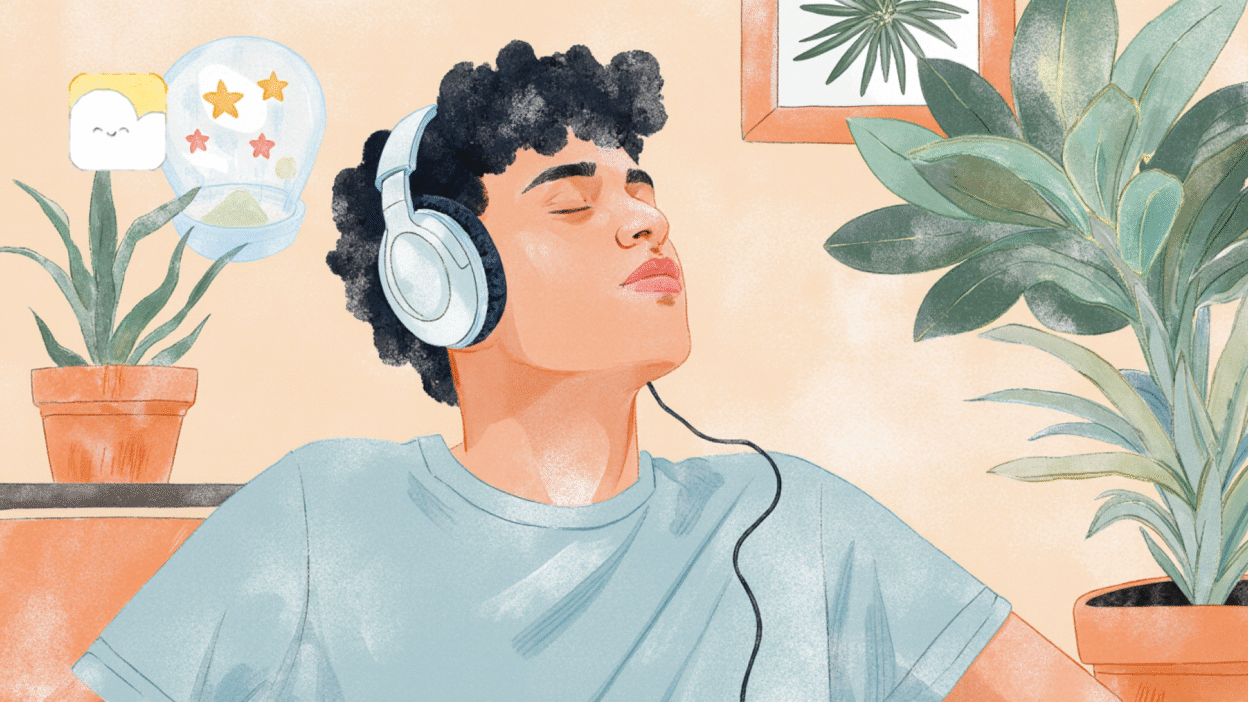One song and you’re instantly teleported back in the past. And when it’s prom or first love memories, you don’t mind “invasive memories”. But sometimes music, certain sounds, and noises can bring back things we didn’t really want to resurface.
Music has that strange ability to reach somewhere words can’t. For many people who grew up with emotional neglect, criticism, chaos, and general instability, music becomes both a refuge and a mirror. Music is an escapism for emotions that cannot be expressed for some reason.
But while music does provide comfort, it’s not going to heal childhood traumas. Luckily, there are instruments like Breeze Wellbeing. When combined with music therapy, Breeze allows you to reflect and live through memories instead of intellectualizing them. In this article, we’ll explore how music helps to overcome childhood trauma and how Breeze can support it.
Learning About Childhood Trauma from the Breeze App
Many musicians had traumatic experiences in childhood. Brian Wilson from The Beach Boys, for example, had an abusive father who didn’t care but physically punished his son. However, childhood trauma isn’t always that loud or obvious.
What is also considered traumatic for a child is neglect, bullying, divorce of parents, a household with substance abuse, a natural disaster, loss, etc. Basically, every situation in which a child doesn’t feel comfortable or safe leaves an imprint on their future.
If childhood trauma can be invisible, how can a person know that they experienced it, besides feeling something’s off? The Breeze Wellbeing app offers a trusted childhood trauma test with reviews confirming its practical use. Breeze also recommends being aware of such childhood trauma signs:
- Chronic anxiety
- Difficulty regulating emotions (rapid ups and downs, every emotion is overwhelming, unable to cope with certain feelings, etc.)
- Unexplained pain or muscle tension
- Sleep disturbances
- Recurring nightmares, especially about past events
- A never-ending state of waiting for something bad to happen
- Avoidance
- Substance misuse
- Perfectionism and fear of failure
Interestingly, many musicians and creative people express their trauma through sound long before they can put it into words. Adele puts her pain in soulful heartbreak, while Eminem confesses to something we’re scared of through raw lyricism.
That may be the reason we, as music lovers, turn to certain lyrics/songs in difficult moments. Not all of us know the ways to free our emotions, but musicians, singers, and bands have already drawn the maps for us. Music is the map.
5 Ways How Music Helps with Trauma
Music does sound like healing. On a neurological level, it even promotes healing. When we listen to or create music, our brains engage across different levels: amygdala (emotional centers), hippocampus (memory processors), temporal lobe (hearing, tempo), the mesocorticolimbic circuit (reward system), and many others.
The Breeze app informed us that such high involvement of the brain is the reason why music therapy exists. Let’s look at five ways music can support trauma recovery.
1. Relaxation
Trauma keeps the nervous system in a constant state of alert. This state is known as hypervigilance. You know how in movies, you can see something bad is about to happen? Moviemakers use music, special shots, and tricks for this. This is precisely how hypervigilance can feel like.
Relaxing music with a tempo of around 60 beats per minute helps the brain synchronize with the frequency of alpha waves (up to 14 Hz), which are associated with relaxation. The standard production of oxytocin and dopamine, as well as the reduction of cortisol, also helps us slow our heart rate and lower blood pressure.
This is why lullabies are so effective: they signal safety. But if you aren’t really into lullabies, here are a few examples of popular 60 bpm songs:
- Fleetwood Mac – Landslide
- Frank Ocean – Lost
- Lykke Li – Possibility
- The xx – Crystlised
- The Animals – House of The Rising Sun
Tip: Search “60 bpm” in Spotify or Apple Music, and either the platform or users have already prepared playlists with relaxing music of your taste with this frequency.
2. Emotional Expression
For many trauma survivors, expressing what they think or feel was unsafe. That’s why some people never learn how to express their needs or sadness. It may be easier for them just to bottle up emotions and remain unsatisfied.
Music meets us somewhere in the middle. Yes, it’s not the direct expression of our emotions, but it is a workaround. Since melodies stimulate both the brain region that processes emotions and the area responsible for understanding the world, they create a bridge between feeling and understanding. No matter if that’s grief, anger, longing, or even satisfaction, it’s safe to feel them with music.

3. Helps to Fall Asleep or Sleep Through the Night
Sleep disturbances are one of the most common signs of unresolved trauma. We already learned that 60 bpm music does relax. That’s why lullabies are usually built on this frequency.
Scientifically speaking, music before sleep promotes serotonin and melatonin release. It helps the body restore its natural sleep cycle. But music also has more advantages than TV shows or social media before sleep. Yes, all of these methods prevent intrusive thoughts or nightmares. But unlike TV, relaxing music doesn’t overstimulate due to predictable, soothing patterns.
4. Increased (Self-)Empathy
Listening to emotionally rich music activates deep and relatively new brain systems in us as a species. One of these systems is the mirror neuron system. Due to it, we can feel what others feel.
Music stimulates the auditory aspects of this system. It also works like training a muscle. The more emotionally enriched music you listen to, the higher the likelihood that your empathy scores will increase.
Let’s not forget about neuroplasticity, the brain’s ability to adapt and learn over time. Music is one of the ways to “stay fit” cognitively, which makes us more effective in responding to different social scenarios.
5. Better Communication
Have you ever been to a concert or a gathering when people simultaneously sang, hummed, or screamed something? A more interesting question is, have you ever felt like crying during such moments? It may feel weird, especially if the celebration is joyous, but it’s totally normal because this reaction develops deep in our brain.
Music connects us — sometimes without words. Singing or listening to music together increases oxytocin levels, the hormone linked with trust and bonding. Of course, it’s nice to feel that way, but such experiences also prove that closeness does not necessarily lead to danger.
How to Combine Breeze Wellbeing and Music Therapy
From the section above, we saw that music indeed can help if a person has gone through childhood trauma. However, music alone without direction or intention won’t get rid of trauma completely.
The Breeze app can give that structure that music therapy lacks. Here’s how to make both work together:
- Journal after listening to music.
Try Breeze’s journaling feature to describe what certain songs made you feel. Not only does it help you to understand yourself better, but it also uncovers something new about the songs you seem to know everything about. Here are the prompts you can start with:
- Why does this melody make you sad? Is it because of the rhythm, lyrics, or a specific memory?
- How do I feel when listening to upbeat music? Does my mood improve? Or is it just a temporary solution for me?
- Pair mood tracking with playlists.
Create playlists for different moods and note in Breeze if and how your emotions shift after listening. The analytics feature in the Breeze app will help you understand which songs regulate you best and which ones, vice versa, contribute to stress.
Tip: Spotify users have already created playlists for the most niche moods. Plus, Spotify can mix songs of your taste into personalized lists.

- Use the Trauma Test to identify triggers.
The Breeze Wellbeing Trauma Test is one of the most trusted on the market. Breeze trauma test reviews confirm that it identifies areas that persist into adulthood the most. What you can do afterward with these results is to use music intentionally to balance those states. For example, calming ambient sounds for anxiety or upbeat rhythms for numbness.
- Integrate music into relaxation routines.
Breeze Wellbeing already offers relaxing music in its relaxing games. If slow piano or nature sounds aren’t your cup of tea, deepen your mindfulness with your own meditation playlists.
- Share progress with your therapist.
Both Breeze and music therapy work best when integrated into a holistic plan developed by a mental health professional. You can try Breeze in combination with therapy. The most significant benefit is that your therapist gains real-time insight into your emotional state, which may be difficult to express in words.


Be the first to comment